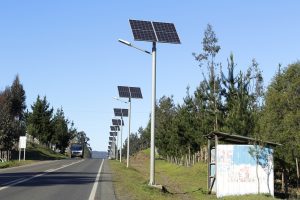 Solar street lighting system is a system for illumination of streets, squares and cross roads. The solar energy is converted into electricity with the help of solar panels. The converted energy is stored in the battery and used for street lighting during night time.
Solar street lighting system is a system for illumination of streets, squares and cross roads. The solar energy is converted into electricity with the help of solar panels. The converted energy is stored in the battery and used for street lighting during night time.
Components
Solar street light system has five major components. They are:
- Solar panels: Solar panels are use to convert solar energy into electricity. There are two types of solar panels. They are: mono-crystalline and poly-crystalline. Conversion rate of poly-crystalline solar panel is less when compared to mono-crystalline.
- Lighting Fixture: Lighting source of solar street system is LED which will consume lower energy when compared to conventional street lights.
- Rechargeable Battery: The converted energy is stored in the battery during day and provide energy during night. There are usually 2 types of batteries: Gel Cell Deep Cycle Battery and Lead Acid Battery.
- Controller: The most important component of solar street system is controller which will decide to switch on/off charging and lighting. In order to charging, lighting and dimming of lights mostly the controllers are programmable.
- Pole: Strong poles must be selected since the components are mounted on the top of the pole.
Features
The features of solar street light system are:
- Protection of short circuit.
- Controllers are highly efficient.
- Resist in all weather conditions.
- Standalone system.
- Package size is small.
Benefits
The benefits of solar street lights are:
- Easy installation.
- Highly benefit to remote areas.
- Electric connection is not required.
- Easy maintenance.
Applications
Solar street lights are used in roads, streets, boundary walls, educational institutions and parks.
